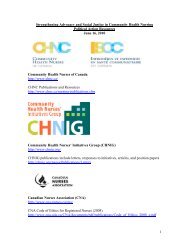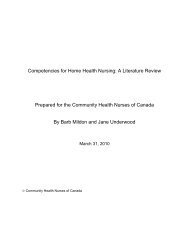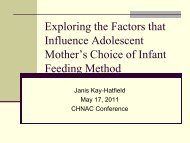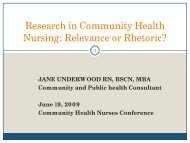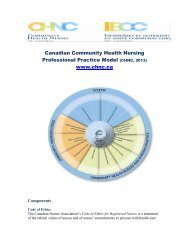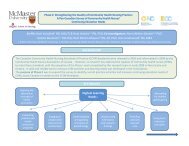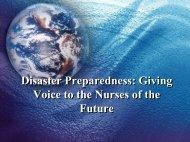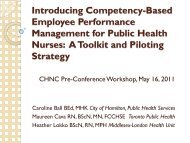Canadian Community Health Nursing Standards of Practice (CCHN ...
Canadian Community Health Nursing Standards of Practice (CCHN ...
Canadian Community Health Nursing Standards of Practice (CCHN ...
You also want an ePaper? Increase the reach of your titles
YUMPU automatically turns print PDFs into web optimized ePapers that Google loves.
Step 2b. Assessing the<br />
Organizational Environment.<br />
The key objective <strong>of</strong> this step is to assess the organizational<br />
environment with a view to integrating the <strong>CCHN</strong> <strong>Standards</strong><br />
into the existing structures and processes that support quality<br />
practice. Knowing what is already in place provides a basis<br />
for change. Teams may feel reluctant to do this type <strong>of</strong><br />
assessment because it is outside their normal responsibilities.<br />
However, it is important to identify what is or is not available<br />
in order to be able to work with the supportive factors and<br />
overcome the challenging ones.<br />
Increasingly, governments and pr<strong>of</strong>essional nursing<br />
organizations are recognizing the importance <strong>of</strong> quality<br />
practice environments to ensure safety, support and respect<br />
for all persons in the work environment (<strong>Canadian</strong> Nurses<br />
Association, 2001; College and Association <strong>of</strong> Registered<br />
Nurses <strong>of</strong> Alberta (CARNA), 2003; College <strong>of</strong> Registered<br />
Nurses <strong>of</strong> British Columbia (CRNBC), 2005; Nurses<br />
Association <strong>of</strong> New Brunswick (NANB), 2005; O'Brien-<br />
Pallas et al., 2005). The CNA has identified five attributes <strong>of</strong><br />
a quality practice environment. These are:<br />
Organizational supports: The organization’s mission,<br />
values, policies and practice should support and value nurses<br />
and the delivery <strong>of</strong> safe and appropriate nursing care.<br />
Pr<strong>of</strong>essional development: Pr<strong>of</strong>essional development is<br />
more than the annual performance appraisal. It begins with<br />
hiring and includes introducing new staff into the<br />
organization, promoting continuing education and reflective<br />
practice, position-specific training and promoting pr<strong>of</strong>essional<br />
development. The <strong>CCHN</strong> <strong>Standards</strong> can contribute to<br />
pr<strong>of</strong>essional development by providing consistency in the<br />
development <strong>of</strong> job descriptions and performance assessment,<br />
and provide a framework to guide continuing education. The<br />
availability <strong>of</strong> nursing human resources is an issue across<br />
Canada. An organization that supports and encourages a<br />
lifelong learning philosophy and promotes a learning<br />
environment is more likely to recruit and retain nurses.<br />
<strong>Nursing</strong> leadership: There should be competent and wellprepared<br />
nursing leaders at all levels in the organization.<br />
Workload management: There should be sufficient nurses<br />
to provide safe, competent, ethical care.<br />
Control over practice: Nurses should have responsibility,<br />
authority and accountability for nursing practice.<br />
These attributes have been translated into quality <strong>of</strong> work<br />
life indicators (QWIs) that make a measurable difference for<br />
pr<strong>of</strong>essional nurses. The indicators are being incorporated into<br />
the <strong>Canadian</strong> Council on <strong>Health</strong> Services Accreditation’s<br />
(CCHSA) 2004 Achieving Improved Measurement (AIM)<br />
Accreditation Program, which is used to accredit healthcare<br />
organizations in Canada (CCHSA, 2004). The <strong>CCHN</strong><br />
<strong>Standards</strong> speak to the community health nurse’s<br />
responsibility with regard to the practice environments;<br />
incorporating the <strong>Standards</strong> into administrative tools will<br />
further facilitate integration <strong>of</strong> the <strong>Standards</strong> and contribute to<br />
a quality practice environment.<br />
If all five attributes are available at a high level, it is likely<br />
that integration <strong>of</strong> the <strong>CCHN</strong> <strong>Standards</strong> will be relatively<br />
straightforward. If some are at a low level, the team will not<br />
be able to work as quickly. By doing the stakeholder<br />
assessment and organizational environmental scan together,<br />
the team will be able to see where opportunities exist and<br />
develop a realistic action plan.<br />
The Environmental Scan Worksheet is designed to gather<br />
information on the attributes <strong>of</strong> a quality work environment<br />
as outlined above. Sample information is included. A blank<br />
worksheet can be downloaded from the CD.<br />
Envir onm ent<br />
16 <strong>Community</strong> <strong>Health</strong> Nurses Association <strong>of</strong> Canada




